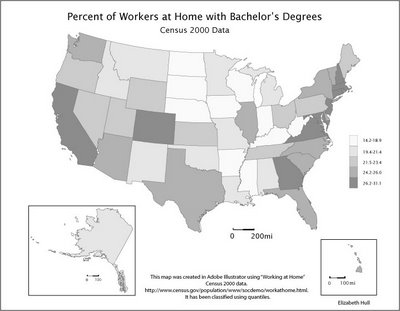Monday, October 23, 2006

For Lab 5 I chose to map The Percentage of Workers at Home with Bachelor’s degrees for all fifty states, http://www.census.gov/population/www/socdemo/workathome.html. True to form, natural breaks produced a map that was largely homogenous thereby emphasizing the outliers in the data. For the second map, I thought it would be useful to see more of the distribution in the data so I chose quantiles, specifically quintiles.
The difference in the maps is quite noticeable. (Map1-Natural Breaks appears on top, Map 2-Quintiles appears on bottom. Clicking on the map will produce a larger view.) In Map 1, classified by natural breaks, West Virginia stands alone as the lowest number of people who work at home with bachelor’s degrees. The North-East corridor, Colorado, and Georgia stand out as the states with the highest percentage of people who work at home and have bachelor’s degrees. New Hampshire, which is ranked in the fourth class, is barely noticeable. The entire rest of the country looks basically the same. A pattern doesn’t seem evident, unless it’s that rural areas tend not to have college educated people working at home.
Map 2 shows more detail of the geographic pattern that begins to emerge in Map 1. From this map it becomes possible to hypothesize on possible reasons for the distribution of the data. For example, the inclusion of California in class 5 and Texas, Florida, Illinois, and the Carolina’s in class 4 leads me to ask: is it possible that more educated workers work at home in large traffic congested cities? Many more questions come to mind as I look at Map 2. Map 1 is useful if I want to see how much of the country falls into the bell shape of the curve of this data and where the outliers are to be found. In order to get a better idea of the actual distribution quintiles were more useful.
